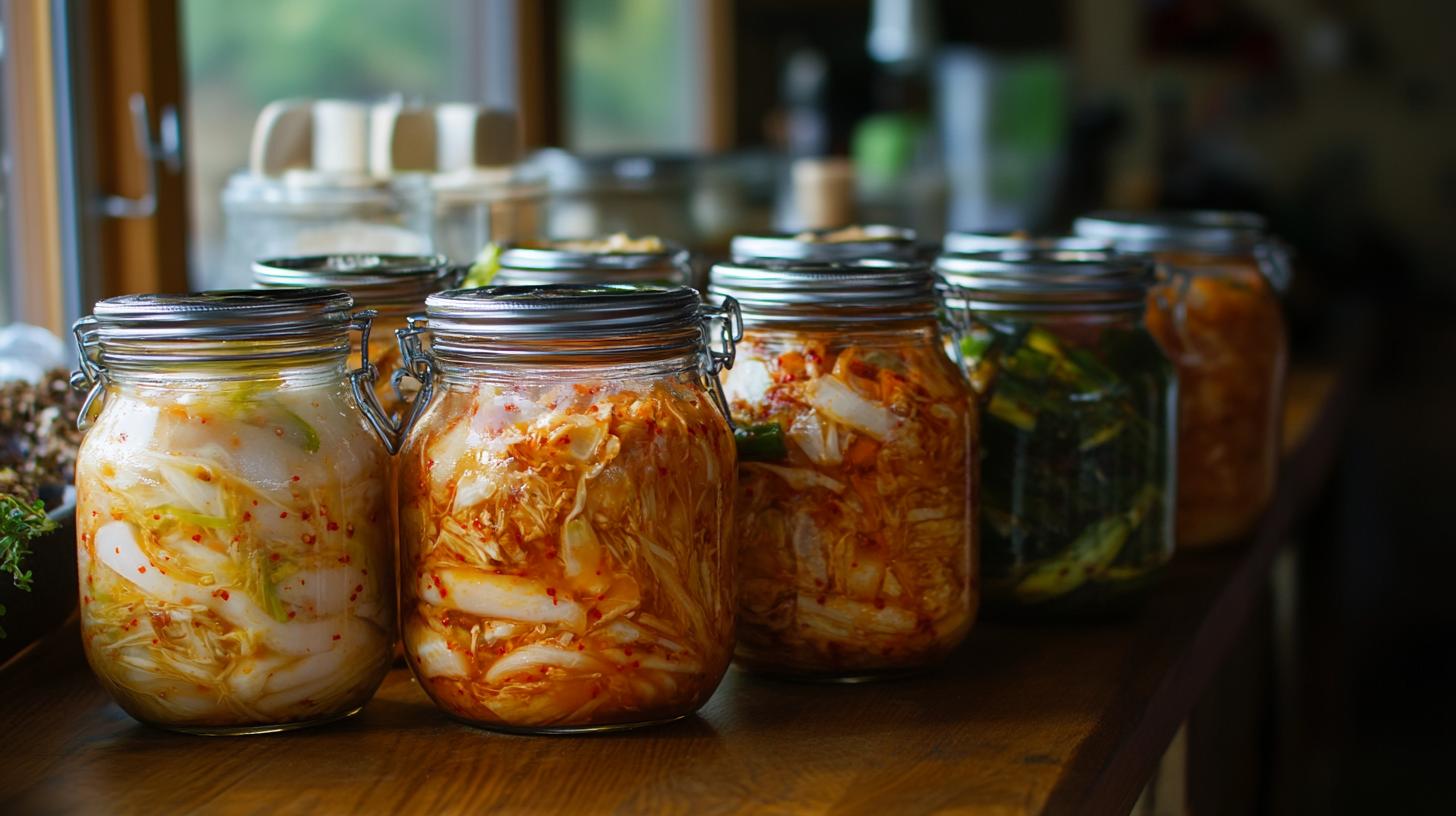Kimchi, a staple in Korean cuisine, is a vibrant and pungent dish that has captured hearts and taste buds worldwide. Known for its distinct tang and delightful spice, this fermented cabbage dish is more than just a side—it’s a cultural experience and a nutritious powerhouse. With roots tracing back thousands of years, kimchi was originally developed as a method to preserve vegetables throughout the winter. Today, it’s celebrated for its probiotic properties, rich in vitamins A and C, and low in calories, making it not only a delectable addition to your meals but also a healthy choice.
On a cold winter evening or at a lively summer picnic, kimchi shines both as a solo performer and a harmonious sidekick to other Asian delights. Each bite offers a chewy yet crisp texture that’s beautifully caressed by the spicy, sour, and umami-rich flavors that develop over time. Whether you’re a seasoned kimchi enthusiast or a curious newcomer, this recipe will guide you to crafting your own vibrant jar of this quintessential Korean delight.
Ingredients:
– 1 head of napa cabbage
– 1/4 cup of sea salt
– Water, enough to submerge the cabbage
– 1 tablespoon of grated garlic (5-6 cloves)
– 1 teaspoon of grated ginger
– 1 tablespoon of sugar
– 3 tablespoons of fish sauce (or vegetarian alternative like soy sauce or mushroom brine)
– 1/3 cup of Korean red pepper flakes (gochugaru)
– 8 ounces of Korean radish or daikon, julienned
– 4 scallions, cut into 1-inch pieces
Instructions:
Step 1: Prepare the Cabbage
1. Cut the napa cabbage lengthwise into quarters and remove the cores. Cut each quarter crosswise into 2-inch wide strips. Rinse the cabbage and drain.
2. Place the cabbage in a large bowl and sprinkle with the sea salt. Mix thoroughly to ensure the salt is evenly distributed. Add enough water to cover the cabbage, weighting it down with a plate. Let it stand for 1 to 2 hours.
Step 2: Make the Seasoning Paste
1. In a small bowl, combine the garlic, ginger, sugar, and fish sauce, stirring until the sugar is dissolved. Add the gochugaru to the paste, using 1 to 5 tablespoons, depending on your preferred spice level. Mix well to form a thick, red paste.
Step 3: Combine Cabbage and Radish
1. Rinse the salted cabbage under cold water 2 to 3 times. Set aside to drain in a colander for 15 minutes, gently squeezing out excess water.
2. In a large mixing bowl, combine the drained cabbage, radish, and scallions.
Step 4: Mix and Pack the Kimchi
1. Wear disposable gloves to protect your hands from the spicy paste. Add the seasoning paste to the vegetable mix, using your hands to combine thoroughly with the cabbage mixture until all pieces are well-coated.
2. Pack the kimchi into a jar or airtight container, pressing down to eliminate air pockets. Leave some space at the top for expansion.
Step 5: Ferment the Kimchi
1. Seal the container and let it sit at room temperature for 1 to 5 days, depending on your taste preference. The warmer your environment, the faster the fermentation. Open the jar daily to release gases and inspect the taste.
Step 6: Refrigerate and Enjoy
1. Once the kimchi reaches the desired fermentation level, transfer it to the refrigerator. Over time, it will continue to ferment slowly and develop deeper flavors.
Tips and Serving Suggestions:
– Temperature and Fermentation: If you’re new to making kimchi, taste it after a couple of days to find your preferred level of fermentation. A moderately cool place will allow fermentation without overly accelerating the process.
– Pairings: Serve kimchi as an accompaniment to rice, noodles, or grilled meats, such as Korean BBQ. It also adds zest to dishes like kimchi fried rice or kimchi pancakes.
– Enhancements: For added depth, consider adding a bit of fermented shrimp (saeujeot) or oysters to your paste for a more traditional flair.
Enjoy this journey into Korean gastronomy, where each crunchy bite offers a taste of history and the promise of a healthier gut!
Unlock the Secret to Perfect Homemade Kimchi: Tips, Tricks, and Pairings
How to Enhance Your Kimchi Experience
Kimchi, a cherished staple of Korean cuisine, is much more than just a side dish; it’s a savory symphony of flavors and a wellspring of health benefits. For those embarking on the delicious journey of making their own kimchi, there are numerous facets to explore beyond the basic recipe. Dive into this enriching guide to optimize your kimchi-making venture and enjoy its cultural and nutritional wealth.
Calories and Nutritional Facts
Kimchi is not only delicious but also low in calories. On average, a 100-gram serving contains approximately 15 calories, making it a guilt-free addition to any meal. It’s packed with vitamins A, B, and C, as well as beneficial probiotics that promote gut health.
Probiotics and Health Benefits
Fermented foods like kimchi are renowned for their probiotic content, which aids in digestion and supports a healthy gut microbiome. The fermentation process also boosts the bioavailability of nutrients, enhancing their beneficial effects on the immune system.
Fermentation Tips
– Temperature Control: Aim for a consistent room temperature of about 65-75°F (18-24°C) to ensure a steady fermentation process. Cooler temperatures will slow down fermentation, which can be suitable for those who prefer a milder flavor.
– Testing Taste: Begin tasting your kimchi after 48 hours to monitor its development. The tangy flavor will intensify over time, so find what best suits your palate.
Ingredient Substitutions
For those with dietary restrictions or preferences, several substitutions can be made without compromising flavor:
– Vegan Option: Replace fish sauce with soy sauce, coconut aminos, or a splash of tamari for a plant-based version.
– Spice Level: Adjust the amount of gochugaru (Korean red pepper flakes) based on your heat tolerance. For a milder version, reduce the quantity or substitute with a mix of paprika and cayenne.
Cooking Techniques and Equipment Recommendations
– Using Gloves: When mixing the spicy seasoning paste into the vegetables, it’s wise to wear disposable gloves to protect your hands from the potent chili oils.
– Optimal Containers: Opt for glass jars or ceramic crocks for fermentation. These materials do not react with the acidic nature of kimchi, preserving its quality and flavor.
Common Mistakes to Avoid
– Over-Salting: While salt is crucial for texture and preservation, too much can overwhelm the dish. Always rinse the cabbage thoroughly after salting to remove excess.
– Improper Sealing: Ensure your containers are airtight to prevent unwanted bacteria from interfering with the fermentation process.
Serving Ideas and Pairing Suggestions
– Traditional Pairings: Kimchi complements a wide array of Korean dishes, such as bulgogi and bibimbap. It’s also a delectable topping for Western dishes like tacos and sandwiches.
– Creative Uses: Incorporate kimchi into your breakfast by adding it to an omelet or scrambled eggs. Or, explore global flavors by mixing it into a hearty stew or soup.
Sustainability Tips
Making kimchi at home is a sustainable practice, allowing you to reduce food waste by fermenting surplus vegetables. Opt for organic and locally sourced produce to minimize your environmental footprint further.
Storage Tips
Once fermented to your liking, store kimchi in the refrigerator to slow down the fermentation process. Properly stored, it can last several months, developing deeper flavors with time.
Embrace the vibrant, multifaceted world of kimchi, where culinary tradition meets modern palate preferences. Whether enjoyed fresh or aged, kimchi offers an exhilarating bite of tradition bound to invigorate any meal. For more on Korean cuisine, explore the diverse offerings on link name.












